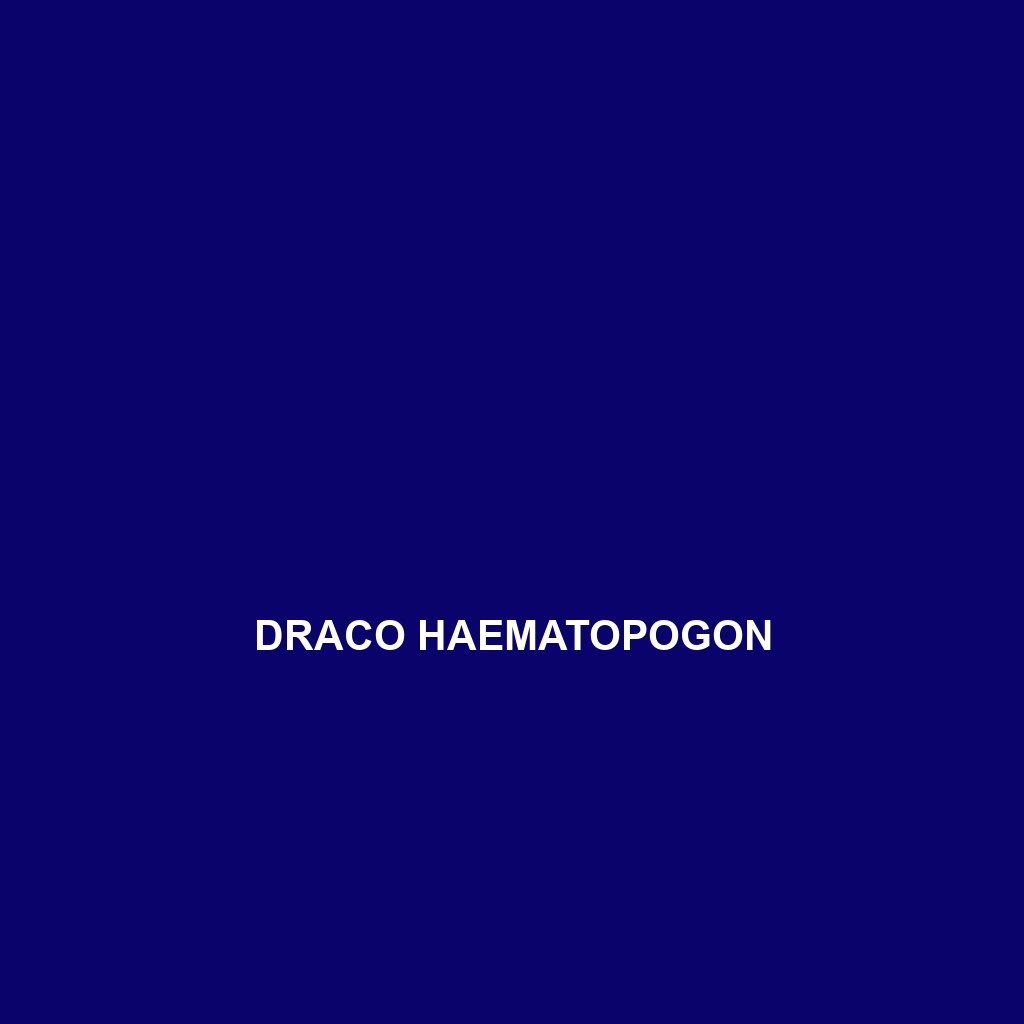Common Name
Draco haematopogon
Scientific Name
Draco haematopogon
Habitat
Draco haematopogon, commonly known as the blood-bearded dragon, thrives in a variety of habitats primarily located in the tropical and subtropical regions of Southeast Asia. This species is predominantly found in lush rainforests, but can also inhabit adjacent savannas and lowland temperate forests. They prefer areas with ample greenery, where they can camouflage effectively against predators and hunt for food. The humid climate of these regions, coupled with the myriad of microhabitats provided by the rainforest layers, supports their diverse life patterns.
Physical Characteristics
Draco haematopogon is notable for its striking appearance, which can be attributed to its vibrant coloration and unique morphological features. Adults typically measure between 20 to 30 centimeters in length, with males often displaying larger and more prominently developed beards. Their body is covered in smooth, glossy scales that exhibit a mix of browns and vibrant reds, providing excellent camouflage within their wooded habitats. A distinctive feature of Draco haematopogon is its elongated throat flap, which can expand to display during mating season or when threatened, offering both a stunning visual display and a means of intimidating rivals.
Behavior
In terms of behavior, Draco haematopogon exhibits a mix of diurnal and some nocturnal habits, primarily being active during the day when sunlight is abundant. Socially, these creatures tend to be solitary except during mating seasons, showcasing remarkable aerial agility as they glide from tree to tree, utilizing their wing-like ribs to navigate through their forested environment. Their mating rituals are particularly fascinating; males perform intricate dances and displays of their vibrant beards to attract females, often engaging in territorial disputes with neighboring males. The sight of these dragons gliding gracefully from branch to branch is a unique spectacle that draws the attention of both researchers and nature enthusiasts.
Diet
Feeding habits of Draco haematopogon classify them primarily as insectivores, with a diet heavily reliant on a variety of insects including ants, beetles, and termites. They have developed specialized feeding patterns, often employing their gliding abilities to hunt insect prey effectively on the move. Their long, sticky tongues are adept at capturing insects mid-flight, demonstrating their remarkable adaptation to a tree-dwelling lifestyle. Occasionally, they may also consume small fruits or flowers, contributing to their varied dietary intake.
Reproduction
The reproductive cycle of Draco haematopogon is seasonal, generally aligning with the humid monsoon periods in their habitat. Mating typically occurs during the late afternoons, where males perform elaborate displays to attract females. After a gestation period that can last up to 60 days, females lay 2 to 5 eggs in small tree hollows or under leaf litter, camouflaged for protection against predators. Parental investment is primarily limited to ensuring the safety of the eggs, with the young hatching after about 50 days and quickly becoming independent, showcasing rapid growth potential.
Conservation Status
As of now, Draco haematopogon is classified as least concern on the IUCN Red List, though it faces potential threats from habitat loss due to deforestation and urban development. Conservation efforts are crucial in maintaining their habitats, and organizations are actively working on protecting their natural environments through sustainable practices. Continued research and monitoring are essential to ensure that this remarkable species does not transition into a more vulnerable status in the future.
Interesting Facts
One of the most fascinating aspects of Draco haematopogon is its ability to glide. They can glide distances of up to 10 meters, which is a significant feat for any reptile. Their unique adaptations also include their ability to change color slightly depending on their mood or environmental conditions. This not only aids in camouflage but also serves as a form of communication during social interactions. Another interesting fact is their role in local ecosystems; as they consume various insect populations, they help control pest numbers, thereby maintaining ecological balance.
Role in Ecosystem
Draco haematopogon plays a critical role in its ecosystem as both a predator of insects and a potential pollinator. By feeding on a wide range of insects, they help regulate pest populations, which benefits the overall health of their habitat. Additionally, their interactions with plants, particularly during feeding, facilitate the pollination process, thereby contributing to the reproductive cycles of many local flora species. These ecological interactions highlight the importance of preserving Draco haematopogon and their habitats, ensuring the continued health and diversity of tropical ecosystems.
